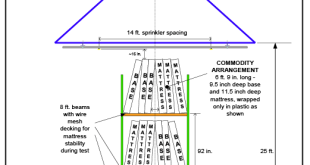Review of NFPA 20 First Draft Report
For the installation of water-based fire protection systems, the NFPA standard development process aligns every three years. During this time, NFPA 13, NFPA 13R, NFPA 13D, NFPA 14, NFPA 20, and NFPA 24 are all under the microscope, with the technical committees reviewing public proposals for changes to the document and making their own changes as experts in the industry—it’s like the World Cup of the fire sprinkler industry! Previous issues have reviewed the actions taken during the first draft stage for NFPA 13, NFPA 13R, and NFPA 13D. This issue will focus on the proposed changes and the next steps for a crowd favorite—fire pumps!
New Definitions
FR-61, FR-110, FR-105, FR-75
Say what you mean and mean what you say. This was a common theme during the NFPA 20 first draft meeting. One effort that AFSA took up was to clean up the language in the standard regarding relief valves. This led to a new definition for “main relief valves,” the organization of the circulation relief valve requirements, and correlation throughout the document.
3.3.78.4.2 Main Relief Valve.
A relief valve designed to automatically relieve excessive pressure caused by an overspeed condition in the driver or engine by discharging water to the environment or back to suction.
The new definition for “main relief valve” will help to aid in the application of correlated requirements throughout the standard involving relief valves, main relief valves, and circulation relief valves.
Qualifications
There is a common theme that has been making its way through the standard development process, and that is the codification of a qualified person. Where the other installation standards were adding language, NFPA 20 needed to be reigned in. There were several references to inspection, testing, and maintenance (ITM) in the qualifications for system installers and a section specific to ITM service personnel. It should be noted that NFPA 20 is an installation document and the committee agreed that the requirements for service personnel qualifications should be deleted. If there needs to be requirements for the qualifications for the ITM personnel, that would be under NFPA 25’s purview. In the eyes of AFSA, the qualifications of our workers are already addressed by local legislatures and contractor licensing required by the states. Any requirement other than an installer must be “qualified” oversteps the scope of an installation standard.
Horsepower Ratings
PI-22, PI-23, CI-66
When determining the power requirements for fire pump motors, NFPA 20 requires the supplied power to operate the pump at any point on the curve up to the maximum pump load. So that means if a fire pump is capable of running at 400-percent capacity, then the motor must be sized to accommodate that point—even though fire protection systems are limited to 150-percent capacity for design! The result is either a grossly over-designed motor or an inefficient fire pump curve that substantially cuts off the head pressure after 150 percent. Seeing this issue, AFSA submitted a public input to reduce the motor size and base the power requirements on the pump running at 175-percent capacity.
4.7.6* The driver shall be selected in accordance with 9.5.2 (for electric motors), 11.2.2 (for diesel engines), or 13.1.2 (for steam turbines) to provide the required power to operate the pump at rated speed and maximum pump load under any flow condition up to 175 percent rated flow.
While this change was approved at the first draft meeting, the first revision failed the letter ballot and was downgraded to a committee input. Opponents of the change cited that the new requirement would overload the pump should an underground main rupture or some other catastrophic events occur. Should we have to over-design the pump to account for every catastrophic event? NFPA 20 is a minimum standard to provide a reasonable degree of protection. The negative comments submitted for CI-66 utilize unreasonable logic and arguments that contradict the negative vote. This issue will resurface at the second draft.
Circulation Relief Valve Requirements
PI-7, PI-46, FR-67
Similar to the impetus for the new definition of “main relief valve,” the requirements for circulation relief valves were revised to clarify meaning and intent. In the original section, the standard used the terms “circulation relief valve,” “automatic relief valve,” and “valve” interchangeably. Then throw in the industry term “casing relief valve,” and the applied intent lacked any consistency. To be concise, the section was reorganized and revised to state “automatic circulation relief valve” in the charging section and then referred to the device as a “circulation relief valve” thereafter.
A technical change was added in the circulation relief valve section to introduce a new technology and installation arrangement to accommodate variable speed pumps. The new(er) technology utilizes a relief valve that actuates based on heat rather than pressure. Since the primary objective of the circulation relief valve is to keep the pump from overheating, this is a great option to have. The only issue is that the new requirement only applies to variable-speed pumps. In the next stage of revisions, AFSA will look to broaden the thermal circulation relief valve’s use to all pump types.
Next Steps
The final version of the First Draft Report is scheduled to be published by mid-March. Once available, the public is able to comment on the draft and propose revisions to sections affected by first revisions, committee inputs, and resolved public inputs. To access the report, navigate to www.nfpa.org/20next. The next issue of Higher Standards will provide a voting guide for the relevant certified amending motions that will be moved at the 2023 NFPA Technical Meeting in Las Vegas. Hope to see you there!
 ABOUT THE AUTHOR: Kevin Hall, M.Eng., P.E., ET, CWBSP, PMSFPE, is the senior manager of engineering and technical services for the American Fire Sprinkler Association (AFSA). He is a member of several National Fire Protection Association (NFPA) technical committees responsible for developing the model codes and standards, including, NFPA 1 Fire Code, NFPA 13/13R/13D Installation of Sprinkler Systems, NFPA 20 Installation of Stationary Fire Pumps for Fire Protection, NFPA 30 Flammable and Combustible Liquids Code, and NFPA 915 Remote Inspections. He also represents AFSA on numerous UL standard technical panels responsible for revising and maintaining the product standards used in the sprinkler industry. He is a registered professional engineer in Delaware and Maryland, NICET III certified in water-based system layout, a certified water-based system professional through NFPA, and a professional member of the Society of Fire Protection Engineers (SFPE). He earned his Bachelor of Science and Master of Engineering degrees from the University of Maryland College Park in fire protection engineering. In 2021, he was recognized as one of SFPE’s “5 Under 35” award recipients. Prior to his association and committee work, he worked for Reliance Fire Protection in Baltimore, Maryland as a project manager overseeing projects of various sizes and complexity for the Contracts Division.
ABOUT THE AUTHOR: Kevin Hall, M.Eng., P.E., ET, CWBSP, PMSFPE, is the senior manager of engineering and technical services for the American Fire Sprinkler Association (AFSA). He is a member of several National Fire Protection Association (NFPA) technical committees responsible for developing the model codes and standards, including, NFPA 1 Fire Code, NFPA 13/13R/13D Installation of Sprinkler Systems, NFPA 20 Installation of Stationary Fire Pumps for Fire Protection, NFPA 30 Flammable and Combustible Liquids Code, and NFPA 915 Remote Inspections. He also represents AFSA on numerous UL standard technical panels responsible for revising and maintaining the product standards used in the sprinkler industry. He is a registered professional engineer in Delaware and Maryland, NICET III certified in water-based system layout, a certified water-based system professional through NFPA, and a professional member of the Society of Fire Protection Engineers (SFPE). He earned his Bachelor of Science and Master of Engineering degrees from the University of Maryland College Park in fire protection engineering. In 2021, he was recognized as one of SFPE’s “5 Under 35” award recipients. Prior to his association and committee work, he worked for Reliance Fire Protection in Baltimore, Maryland as a project manager overseeing projects of various sizes and complexity for the Contracts Division.
 Sprinkler Age A Publication of the American Fire Sprinkler Association
Sprinkler Age A Publication of the American Fire Sprinkler Association



